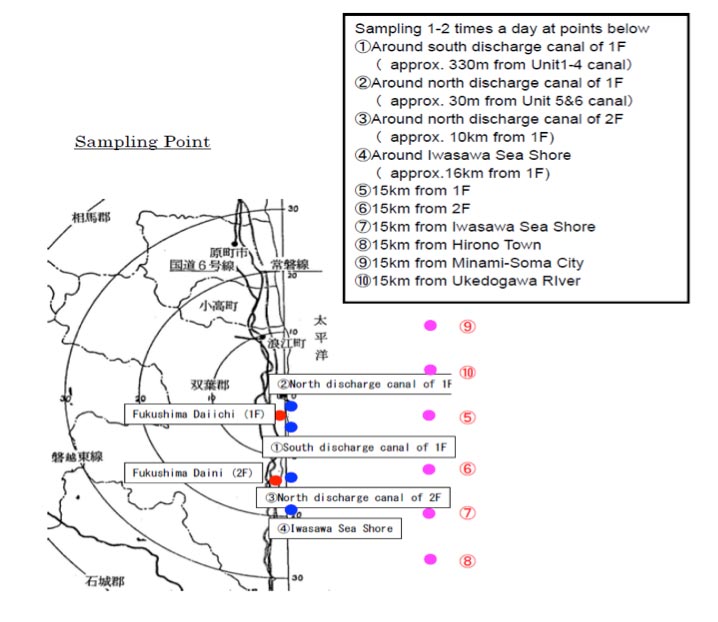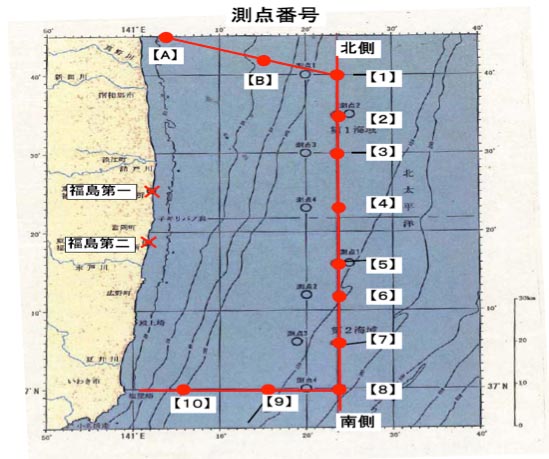→ Chronology of Updates:
2 June | 12-18 May | 4-11 May | 5 May | 3 May | 2 May | 28 April | 27 April | 26 April | 21 April | 20 April | 19 April | 18 April | 15 April | 14 April | 13 April | 12 April | 11 April | 10 April | 9 April | 8 April | 7 April | 6 April | 5 April | 4 April | 3 April | 2 April | 1 April | 31 March | 30 March | 29 March | 28 March | 27 March | 26 March | 25 March | 24 March | 23 March | 22 March | 21 March | 20 March | 19 March | 18 March | 17 March | 16 March | 15 March | 14 March | 13 March | 12 March | 11 March | Full Update
IAEA BRIEFING ON FUKUSHIMA NUCLEAR ACCIDENT (14 April 2011, 15:30 UTC)
Presentation:
→ Summary of Reactor Status
On Thursday, 14 April 2011, the IAEA provided the following information on the current status of nuclear safety in Japan:
1. Current Situation
Overall, the situation at the Fukushima Daiichi plant remains very serious but there are early signs of recovery in some functions such as electrical power and instrumentation.
Earthquake of 13 April
The NISA Press Release reported that an earthquake occurred at Hamadori in Fukushima prefecture on 13 April, at 01:07 UTC. The earthquake had a moment magnitude of M 5.4 and was at a depth of 24.7 km, as reported by the IAEA International Seismic Safety Centre. The distances from the earthquake's epicenter to Fukushima Daini and Fukushima Daiichi nuclear power plant were 67 and 75 km respectively. No unusual events have been reported at the near sites (Onagawa, Fukushima Daiichi, Fukushima Daini and Tokai).
Changes to Fukushima Daiichi Plant Status
Freshwater injection is confirmed to continue for Units 1 to 3. The transfer of contaminated water from Unit 2 turbine building to the condenser was started (12 April) and suspended (13 April) to check for any leakage. Temperature at the Unit 1 outlet nozzle shows a decreasing trend continuously for several days now.
To minimize migration of contaminated water to the open sea, on the ocean-side of the Inlet Bar Screen of Unit 2, the two temporary steel plates (3 plates in total) were installed to stop water from leaking out of the inlet bay (around 08:30 untill 10:00, 13 April). In addition, a silt fence to prevent the spread of the contaminated water was installed in front of the Screen of Units 3 and 4. (13:50 UTC, 13 April).
In Unit 1 fresh water is being continuously injected into the RPV through the feed-water line at an indicated flow rate of 6 m3/h using a temporary electric pump with off-site power. In Units 2 and 3 fresh water is being continuously injected through the fire extinguisher lines at an indicated rate of 7 m3/h using temporary electric pumps with off-site power.
Nitrogen gas is being injected into the Unit 1 containment vessel to reduce the possibility of hydrogen combustion within the containment vessel. The pressure in this containment vessel has stabilised. The pressure in the RPV is increasing as indicated on one channel of instrumentation. The other channel shows RPV pressure as stable. In Units 2 and 3 Reactor Pressure Vessel and Drywell pressures remain at atmospheric pressure.
RPV temperatures remain above cold shutdown conditions in all Units, (typically less than 95 °C). In Unit 1 the temperature at the feed water nozzle of the RPV is 206 °C and at the bottom of the RPV is 119 °C. In Unit 2 the temperature at the feed water nozzle of the RPV is 167 °C. In Unit 3 the temperature at the feed water nozzle of the RPV is 92 °C and at the bottom of the RPV is 119 °C.
On 12 April in Units 3 and 4, fresh water (35 T and 195 T respectively) was sprayed over the Spent Fuel Pools using a Concrete Pump Truck. A sample of the water in the spent fuel pool was collected for analysis.
There has been no change in status in Unit 5 and 6 and the Common Spent Fuel Storage Facility.
2. Radiation Monitoring
On 13 April, deposition of both I-131 and Cs-137 was detected in 2 and 5 prefectures respectively. For both, I-131 and Cs-137, the depositions detected were below 20 Bq/m2 at all stations.
Gamma dose rates are measured daily in all 47 prefectures. The values tend to decrease over time. For Fukushima, on 13 April a dose rate of 2.0 µSv/h was reported. In the Ibaraki prefecture, a gamma dose rate of 0.14 µSv/h was reported. The gamma dose rates in all other prefectures were below 0.1 µSv/h.
Dose rates are also reported specifically for the Eastern part of the Fukushima prefecture, for distances beyond 30 km from Fukushima-Daiichi. On 13 April, the values in this area ranged from 0.2 to 26 µSv/h.
In addition to the 7 measurements referred to in yesterday's brief, (note- these measurements were made at distances of 25 km and 33 km not 32 km and 62 km as reported), 13 more measurements were made on 12 April at distances of 25 to 33 km, West and Northwest from the Fukushima Nuclear Power Plant by the IAEA team. At these locations, the dose rates ranged from 0.5 to 16.5 µSv/h. At the same locations, results of beta-gamma contamination measurements ranged from 0.05 to 2.1 Megabecquerel/m2.
On 13 April, the IAEA Team made measurements at 7 different locations in the Fukushima area at distances ranging from 32 to 62 km, North and Northwest from the Fukushima Daiichi nuclear power plant. At these locations, the dose rates ranged from 0.35 to 2.6 µSv/h. At the same locations, results of beta-gamma contamination measurements ranged from 0.35 to 2.6 Megabecquerel/m2.
Analytical results related to food contamination were reported by the Japanese Ministry of Health, Labour and Welfare on 13 April that covered a total of 98 samples taken on 4 and 11 to 13 April. Analytical results for 76 of the samples of various vegetables, pork, seafood and unprocessed raw milk in nine prefectures (Chiba, Fukushima, Gunma, Ibaraki, Kanagawa, Miyagi, Niigata, Saitama and Yamagata) indicated that I-131, Cs-134 and/or Cs-137 were either not detected or were below the regulation values set by the Japanese authorities. In Fukushima prefecture on 11 April, twenty samples of various vegetables were above the regulation values set by the Japanese authorities for Cs-134/Cs-137, and one sample of seafood (sand lance) and one sample of spinach were above the regulation values set by the Japanese authorities for both I-131 and Cs-134/Cs-137.
3. Marine Monitoring
TEPCO Monitoring Programme
TEPCO is conducting a programme for seawater (surface sampling) at a number of near-shore and off-shore monitoring locations. (See Map 10: TEPCO Seawater Sampling Locations).
On some days, two samples were collected at the same sampling point, a few hours apart and analysed separately.
Until 3 April a general decreasing trend in radioactivity was observed at the sampling points TEPCO 1 to TEPCO 4. After the discharge of contaminated water on 4 April, a temporary increase in radioactivity has been reported.
On 11 April decreasing trends for both I-131 and Cs-137 concentrations of two orders of magnitude from near-shore (less than 10 kBq/l) to 15 km off-shore (0.1-0.02 kBq/l) were observed.
On 14 April no new data for TEPCO 1 - 10 sampling points have been reported.
MEXT Off-shore Monitoring Programme
Japanese Ministry of Education, Culture, Sports, Science and Technology (MEXT) initiated the off-shore monitoring program on 23 March and subsequently points 9 and 10 were added to the off-shore sampling scheme. On 4 April, MEXT added two sampling points to the north and west of sampling point 1. These are referred to as points A and B. (See Map 11: MEXT Seawater Sampling Locations).
On 11 April Cs-137 was only detected at MEXT 4 at a concentration level of about 70 Bq/l. The highest concentration of I-131 (about 90 Bq/l) was also recorded at MEXT4. For other sampling locations I-131 was reported at levels below about 15 Bq/l.
0n 14 April no new data for all MEXT sampling points have been reported.
Map 10: TEPCO Seawater Sampling Locations:

Map 11: MEXT Seawater Sampling Locations:

4. IAEA Activities
The 141st Session of the FAO Council will be briefed by representatives of the Joint FAO/IAEA Division on the nuclear emergency in Japan on Friday, 15 April, at FAO Headquarters in Rome, Italy. The briefing will include a general background summary of the emergency, the current situation in Japan, FAO/IAEA/WHO responses and actions taken to date, and future challenges.

